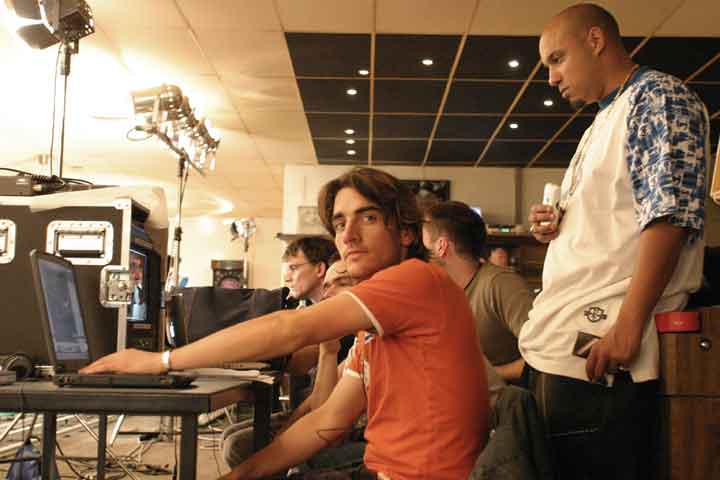
Alex Feil and "D-Flame"
Six: "Dreckig"
 |
|
Alex Feil and "D-Flame" |
 |
|
Björn, Tim and the Hardware |
Last summer I spent my time rendering and uprooting trees, so for 2004 I wished for something better. I got it in the shape of a music video clip to supervise. It was a german hip-hop-track, the labes was noizmakers, the director was Alex Feil, producer Falk Prahl and the original post-supervisor was my old friend Björn Adamski from the Werkstatt. The concept called for motion control, HD and previz, so I did the previz in Softimage XSI, organized and supervised the effects part while Björn handled the infrastructure, negotiated equipment and squeezed necessary information from the various sources, something that proved to be a full time job as nobody had any idea of the inner workings of the Panasonic VariCam. As the host of equipment offered by Panasonic didn´t lend itself to lossless recording we went for a Mac with Apple XServe RAID to connect directly to the camera, recording 60fps HD without a hint of a problem.
The concept was to do a pretty different clip to what you´d expect from the title. The performer was to walk across a bowling track and interact and act together with doubles of himself. Which, of course, called for a motion control camera to perform identical camera moves for each instance of the performer shot. The actual motion control work was supervised by Gunnar Kaiser, the equipment operated by Tim Mendler, lighting and camera was supervised by Tobias Rupp.
 |
|
Alex explains the action to "Six" using |
The bowling track made some things easier, mostly the terminology: Each seating aisle matched two bowling tracks. In total there were ten aisles and twenty tracks.
The performance was planned in Softimage XSI where the Realtime Shaders and comfortable setup-abilities allowed for flexible stand-ins. It was also quite easy to derive camera angles and movement speed from the previz. When the director was content with the action it was up to me to match the so-called "virtual" tracks to those filmable on the set. Unfortunately the incredible depth of the tracks meant that only a few tracks in the middle of the alley could be panned through with neither wall into the image.
 |
|
me and Björn Adamski compositing |
As the seats and tables were less than similar and the whole floor bent through in the middle the idea of motion control was somewhat sabotaged. The solution was to reduce the whole shooting to three segments running through the whole track each, so only two rotoscoping-intensive transitions were needed to match the end of the alley to the beginning. All we had to do was to make sure the performers were outside the angle at the start and the end of the take.
It almost worked. Unfortunately the Motion Control rig sank a bit into the carpet, some performers accidently stepped onto the rails, a light had to be replaced...the usual range of minor mishaps.
The Compositing stage was pure rotoscoping frenzy, especially when the director wanted to reuse some actors on different tracks and aisles that just wouldn´t match. The twist was that we did 60 fps, and though the work was easy due to the incredible sharpness and resolution of the image, it was 2,4 as much work as in PAL. It also caused a lot of data to distribute to the machines, but that particular bug was squashed with a Gigabit switch that allowed the footage to remain on the RAID.
Production was fun and the Werkstatt proved to be able to deal with complex HD productions from the cradle to the tape.
the video is here